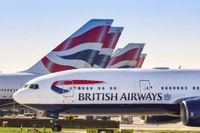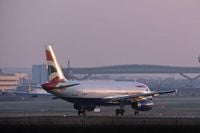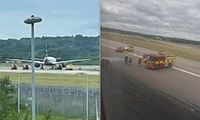A British Airways flight caught fire at Gatwick Airport after a co-pilot mixed up his left and right hands during take-off, according to a report released by the Air Accident Investigation Branch (AAIB). The incident on June 28, 2024, involved flight BA2279 bound for Vancouver with 347 people aboard.
The co-pilot, an experienced airman with more than 6,000 flying hours, pulled back with his left hand during take-off when he should have done so with his right. This "action slip" led to a rejected take-off and a brake fire as the pilot was forced to perform a high-speed emergency stop after reaching speeds of more than 190 mph.
Despite being "well-rested and feeling fine" at the time of the flight, the first officer "could not identify a reason" why he mixed up his hands, the AAIB report stated. The report revealed the pilot had just returned from annual leave, having last flown two weeks prior to the incident. He expressed surprise at his own inadvertent thrust reduction.
The mishap caused significant disruption at Gatwick Airport, which was temporarily closed. Sixteen inbound flights were diverted elsewhere, including an Emirates A380 flight from Dubai that was forced to land in Brussels. A further 23 departures were cancelled, potentially costing airlines millions of pounds according to Eurocontrol estimates.
Airliner co-pilots typically use their left hands to operate the aircraft's thrust levers, which control its engines, and their right hands on the control column. At take-off, the pilot must pull back on the control column, raising the airliner's nose so it lifts into the sky. Instead, the co-pilot throttled back right at the point where the aircraft needed maximal thrust to get airborne. Although he "momentarily" pushed the levers forwards again, his training kicked in. Two seconds after the "action slip", the co-pilot cut the power and applied the brakes from a speed of 186 mph.
None of the 347 people on the Boeing 777 were injured. A British Airways spokesperson said: "Safety is always our highest priority and our pilots brought the aircraft to a safe stop. We apologised to our customers and our teams worked hard to get them on their way as quickly as possible." At the time of the incident, BA had described it as a "technical issue" when explaining the cancelled take-off.
The AAIB report, published on May 8, 2025, detailed the events leading up to the incident, noting that the co-pilot had expressed surprise over his mistake, stating he was "well-rested and feeling fine" but could not pinpoint any reason for the mix-up. This left investigators puzzled, as he had not recently changed aircraft seat or type, nor had he practiced landings or rejected take-offs in a simulator.
The co-pilot's confusion resulted in a dramatic sequence of events. As he unintentionally pulled the thrust lever back with his left hand, the aircraft's thrust was reduced just as the captain was preparing for take-off. This critical error meant that instead of lifting off, the plane began to decelerate, causing the pilot to implement an emergency stop.
The emergency stop was executed at 192 mph, leading to the aircraft being brought to a halt some distance before the end of the runway. Fire and rescue services were promptly dispatched to the scene to extinguish the fire that had ignited on the right main landing gear.
The incident not only raised safety concerns but also highlighted the potential consequences of human error in aviation. With the airport's main runway temporarily closed, it caused chaos for travelers, leading to significant delays and cancellations.
A spokesperson for Gatwick Airport stated, "The main runway was closed for 50 minutes today due to a departing aircraft having hot brakes. Safety is our top priority and London Gatwick’s dedicated airport fire service swiftly attended to support the aircraft." The spokesperson added that the runway was reopened and operating normally after the incident.
In the aftermath, British Airways reiterated its commitment to safety, emphasizing that the pilots acted swiftly to manage the situation. "We apologise to customers for the inconvenience caused," the airline stated, highlighting the importance of safety protocols and the quick response of emergency services.
The AAIB report serves as a reminder of the rigorous safety standards in place within the aviation industry, but it also underscores the need for continuous training and awareness among flight crews. The co-pilot's experience, although extensive, did not prevent this rare but critical mistake.
As investigations continue, the focus remains on ensuring that such incidents are minimized in the future. The airline industry, which prides itself on its safety record, must learn from these occurrences to enhance training and operational procedures, ensuring that pilots can perform their duties without error.
In conclusion, while the incident was alarming, it ended without injury, thanks to the quick actions of the flight crew and emergency responders. The lessons learned from this episode will undoubtedly contribute to improving safety measures and preventing similar occurrences in the future.






